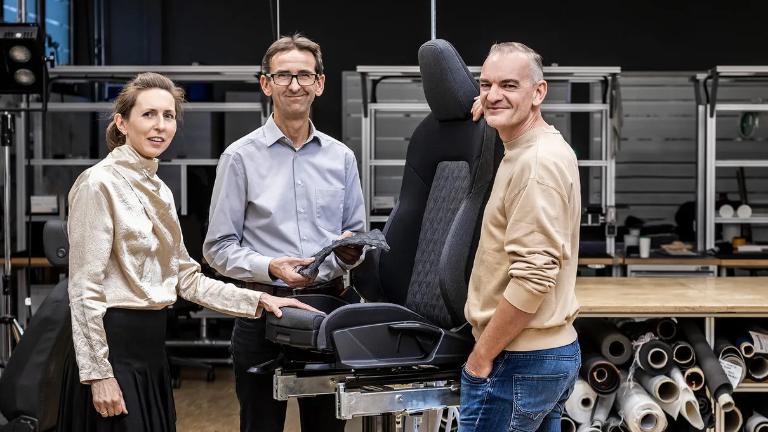Rethink: reasoning about the end from the beginning
Audi is committed to the responsible use of resources along the entire value chain. With this in mind, the principles of the circular economy must be increasingly applied from the earliest stages of development-a vision that finds concrete expression in the Rethink approach.
In the linear economic model, raw materials are used once and then disposed of when the product reaches the end of its life cycle. In the circular economy, on the other hand, components and materials are reused through a series of processes: maintenance, repair, remanufacturing, reconditioning or recycling. Audi's vision of the circular economy is based on three principles: reduce, reuse and recycle, and aims to steadily increase the percentage of secondary material used in new vehicles.
With the next generation of electric cars, based on the Scalable Systems Platform (SSP), Audi intends to intensify the use of post-consumer material, largely from products already used by end consumers.
Recycling of materials
Considering the operations required for disassembly and disposal and the subsequent separation of the materials used, recycling in these cases is much more complex than for post-industrial materials, which are themselves waste from production processes. The latter are generally sorted and collected separately, which means their composition is known; therefore, they can be transformed relatively easily into post-industrial recycled materials, which are generally of higher and more consistent quality. And it is precisely this that makes Audi's strategy of focusing on post-consumer recycled materials while maintaining the quality of the original material (avoiding so-called downcycling) even more ambitious.
The Rethink approach is applied much earlier, that is, at the initial stage of product development, and is embodied in “Design for Circularity”: components developed according to this principle already consider subsequent recyclability, right from the design stage. For components developed in this way, aspects such as suitability for disassembly, repair, maintenance and recycling are taken into account from the first moment. “It's much more than 'just' design,” explains Christine Maier, Designer in the Color & Trim team at AUDI AG. “We are changing the approach with which we develop vehicles. Our starting point is the end: before a product begins its life cycle we think about how it will end and how we can design it in line with the principles of the circular economy.”
Achieving the goal, and ensuring that components and materials can be reused and recycled as much as possible, requires teamwork involving experts from various departments: design, technical development, purchasing and quality control.
Consider circularity as early as possible
In practice, how do these teams collaborate? Let's take a significant example: the seat cover, a component that is subject to significant wear and tear and plays a key role in terms of comfort.
A seat consists of three parts: the supporting structure, the cushion and the cover. For the cover, the surface is bonded with a base material. The joining of the different layers gives stability to the seat upholstery, which can then maintain its shape for a long time. So far, as a standard in the automotive industry, several families of materials have been used for seats: generally, polyester and polyurethane foam.
Within the technical development department, Günther Ernst is responsible for the development of textile materials for the interior trim: “The problem is that two different groups of materials are used, which are difficult to separate for later recycling when the seat reaches the end of its life cycle after two or three decades under normal use. And it is precisely the separation of material groups by type that is critical for recycling.”
Mono-materiality, the key to circularity
The impurities that are formed, due to the mixing of different materials, have a negative impact on the recycling process and can lead to what is known as downcycling, meaning that the product of the recycling process would be of lower quality than the original product. To avoid such a situation, there are two options: design products in such a way that the separation of materials occurs smoothly or use monomaterials.
And precisely the latter is the way, for Audi. The newly developed seat cover comprises a single family of materials. The seat surface, adhesive and base material are all polyester-including a high percentage of recycled polyester. Due to mono-materiality, waste generated during the production of the seat cover can be recycled directly. The scraps are shredded, melted and processed into new yarn, which serves as the basis for the new upholstery. At the end of their useful life, such upholstery can be fed back into the recycling process. Raw materials can be recycled three to five times, rather than just once as in the case of traditional covers.
Christine Maier: “As an automotive manufacturer, we have a responsibility that goes beyond pure aesthetics. It goes without saying that the seats of the future will have to at least look the same and be at least as comfortable as their traditional predecessors. But they will also have to be easier to recycle.”
Quality
Even newly developed single-material upholstery must of course meet specific requirements, including in terms of quality. Jürgen Frank is responsible for the quality of the fabrics inside the vehicle, from the initial development phase to final use on board: “There are about 30 factors we use to test seat covers: for example, strength, elasticity, lightfastness and wear.” What are the requirements for the quality of new single-material upholstery? “There is no distinction between the quality of recyclable and conventional materials. An Audi seat must perform, regardless of how it is designed. In quality tests, the newly designed upholstery must perform just as well; we owe that to our customers.”
The team is working to further reduce the material mix of the entire seat in future stages of development. For example, the joining elements between the upholstery and the seat cushion will also be made of polyester.
